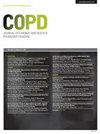A Network Meta-Analysis of Aerobic, Resistance, Endurance, and High-Intensity Interval Training to Prioritize Exercise for Stable COPD
IF 3.1
3区 医学
Q1 Medicine
International Journal of Chronic Obstructive Pulmonary Disease
Pub Date : 2024-09-16
DOI:10.2147/copd.s476256
引用次数: 0
Abstract
Purpose: While the benefits of exercises for chronic obstructive pulmonary disease (COPD) are well-established, the relative effectiveness of different exercise types for stable COPD remains unclear. This network meta-analysis aims to investigate the comparative effects of aerobic exercise (AE), resistance training (RT), endurance training (ET), and high-intensity interval training (HIIT) in stable COPD.Methods: Electronic searches were performed in PubMed, Embase, and the Cochrane library to identify relevant randomized controlled trials (RCTs) investigating the effects of exercises on 6-minute walk test distance (6MWD), forced expiratory volume in one second (FEV1), and forced vital capacity (FVC), and St. George’s Respiratory Questionnaire (SGRQ) score. Two authors screened the retrieved articles, extracted relevant data, and assessed the risk of bias. Network meta-analysis was conducted using Stata 14.0.
Results: This study included a total of 19 studies involving 951 patients with stable COPD. HIIT emerged as the most favorable exercise type for enhancing 6MWD, with a probability of 82.9%. RT exhibited the greatest efficacy in reducing SGRQ scores, with probability of 49.8%. Notably, ET demonstrated superiority in improving FEV1 and FVC, with probabilities of being most effective at 78.1% and 42.0%, respectively.
Conclusion: This study suggests that HIIT may be a viable intervention for improving exercise capacity in stable COPD patients, compared to AE, RR, and ET. RT may hold promise for improving quality of life, and ET may demonstrate superiority in improving pulmonary function. However, variation in response likely depends on patient characteristics, program parameters, and delivery context. Future research should explore the synergistic effects of combining RT with ET/HIIT, focusing on patient subgroups, optimal dosing, and settings, as current guidelines indicate this combination may offer the most significant benefits.
Keywords: COPD, exercise, pulmonary function, quality of life, network meta-analysis
对有氧、抗阻力、耐力和高强度间歇训练进行网络元分析,确定稳定型慢性阻塞性肺病患者的运动优先顺序
目的:虽然运动对慢性阻塞性肺病(COPD)的益处已得到证实,但不同运动类型对稳定期慢性阻塞性肺病的相对效果仍不明确。本网络荟萃分析旨在研究有氧运动(AE)、阻力训练(RT)、耐力训练(ET)和高强度间歇训练(HIIT)对稳定期慢性阻塞性肺病的比较效果:在 PubMed、Embase 和 Cochrane 图书馆中进行了电子检索,以确定研究运动对 6 分钟步行测试距离(6MWD)、一秒钟用力呼气容积(FEV1)、用力肺活量(FVC)和圣乔治呼吸问卷(SGRQ)评分影响的相关随机对照试验(RCT)。两位作者筛选了检索到的文章,提取了相关数据,并评估了偏倚风险。使用 Stata 14.0 进行网络荟萃分析:本研究共纳入 19 项研究,涉及 951 名慢性阻塞性肺病稳定期患者。HIIT是最有利于提高6MWD的运动类型,概率为82.9%。RT 在降低 SGRQ 评分方面表现出最大的功效,概率为 49.8%。值得注意的是,ET 在改善 FEV1 和 FVC 方面表现出优势,其最有效的概率分别为 78.1% 和 42.0%:本研究表明,与AE、RR和ET相比,HIIT可能是提高慢性阻塞性肺病稳定期患者运动能力的可行干预措施。RT可能有望改善生活质量,而ET可能在改善肺功能方面更具优势。然而,反应的差异可能取决于患者特征、项目参数和实施环境。未来的研究应探索将 RT 与 ET/HIIT 结合使用的协同效应,重点关注患者亚群、最佳剂量和环境,因为目前的指南显示这种组合可能会带来最显著的益处:慢性阻塞性肺病、运动、肺功能、生活质量、网络荟萃分析
本文章由计算机程序翻译,如有差异,请以英文原文为准。
求助全文
约1分钟内获得全文
求助全文
来源期刊

International Journal of Chronic Obstructive Pulmonary Disease
RESPIRATORY SYSTEM-
CiteScore
5.10
自引率
10.70%
发文量
372
审稿时长
16 weeks
期刊介绍:
An international, peer-reviewed journal of therapeutics and pharmacology focusing on concise rapid reporting of clinical studies and reviews in COPD. Special focus will be given to the pathophysiological processes underlying the disease, intervention programs, patient focused education, and self management protocols. This journal is directed at specialists and healthcare professionals
 求助内容:
求助内容: 应助结果提醒方式:
应助结果提醒方式:


